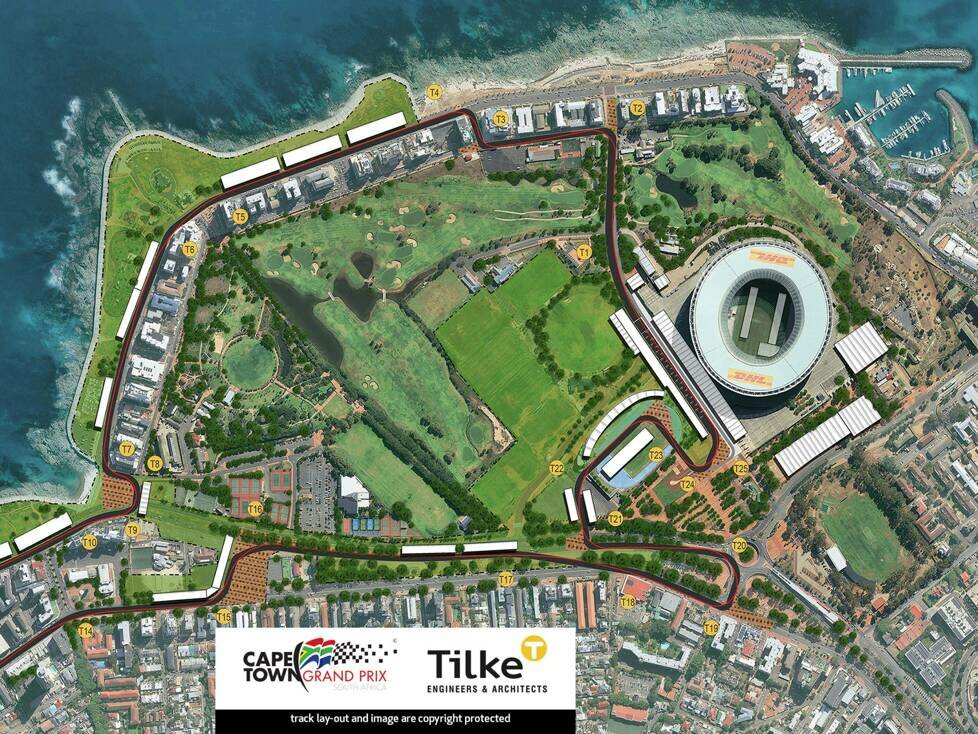The organizers behind Cape Town’s Grand Prix bid explain the concept of their ambitious plans for a Formula 1 city race
The South African government is on the verge of deciding which bid to support to bring Formula 1 back to the country. The Cape Town bid organizers have now presented the latest changes to their proposal for an urban race.
Previous bids to revive the South African Grand Prix at Kyalami had failed, but the government has announced a new initiative to bring the race series back to the country and launched an official bidding process earlier this year.
A possible comeback at a renovated circuit in Kyalami and a proposed city street race along Cape Town’s waterfront are the two main candidates for government support. The bid committee is expected to make its decision by the end of April.
The Cape Town bid is counting on the central, urban location of its 5.7-kilometer circuit, designed by Hermann Tilke and winding around the Green Point harbor and using the infrastructure of the DHL Stadium built for the 2010 World Cup, to give it the decisive advantage.
Cape Town wants to score with these arguments
“The latest design has all the extras,” says Igshaan Amlay, managing director of the Cape Town GP, “It leads partly along the shoreline and also uses the facilities that were already used for the World Cup.”
“We meet all the requirements – the airport is only 15 to 20 minutes away from the circuit, we have a top hospital on site and numerous hotels within walking distance. What also plays a major role are the natural backdrops such as Robben Island, the Waterfront and Table Mountain. As a top tourist destination, Cape Town has a lot to offer.”
“Our competitor is Kyalami, which has a rich Formula One history. So it’s a street circuit against a permanent racetrack. We’ll wait and see how the decision turns out. We could easily accommodate 250,000 people here, which would make the race more accessible to more people.”
Unlike previous proposals, the current design would not take the route through the DHL Stadium itself, but along it – using the stadium for paddock, media center and VIP areas.
“The idea of driving through the stadium was based on the fact that it has a capacity of up to 70,000 people, and we wanted to use it to make the event accessible to people who would otherwise not be able to afford to visit Formula 1,” explains Amlay.
“However, after discussions with the track designers, it became clear that there were some obstacles and it would be better to run the track along it.”
“The DHL Stadium will be used for the paddock and the media center. Everything that was built for the World Cup will be reactivated. It already exists and will therefore be fully utilized. But we will drive through the original Green Point athletics stadium, which has a significant history.”
Competition from other countries is fierce
But even if the government decides in favor of Cape Town or Kyalami, an actual return of Formula 1 to South Africa remains uncertain. The bid must be convincing enough to persuade the Formula 1 officials – especially in the face of competition from countries such as Thailand, Rwanda and South Korea, which are also seeking a place on the race calendar from 2028.
Furthermore, it remains questionable how much public and private funding can be generated for the event. Potential sponsors are currently waiting for the government’s decision. Amlay emphasizes: “I think Formula One has always had the goal of hosting a race on the African continent.”
“Lewis Hamilton has also publicly spoken in favor of it. If you really want to be a world championship, you need a race in Africa – be it in Cape Town, Kyalami or in another African country. It should have a positive impact on our economy and our tourism sector – not only for the city, but for the whole country.”
Amlay has been working on his dream of bringing Formula One to Cape Town for over two decades, without success so far. He has held talks with former Formula One boss Bernie Ecclestone in the past, but he now sees real momentum behind his project as the popularity of Formula One has reached new heights.
“We have never shied away from criticism. Whenever someone criticized us, we took it seriously and made changes,” he adds. ”When we presented the idea in 2016, we had interest from various sponsors and investors.”
“The big problem was that we didn’t get any support from the government. But now there is this big push, and we have huge support from the young generation that follows and enthusiastically supports Formula 1.”
“We’ve come a long way since our first vision in 1999, but we always believed in it. If you believe in something and persevere, it will happen.”





